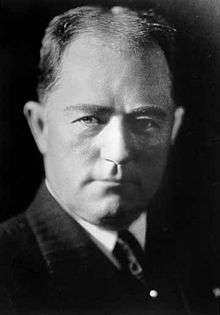Henry Pomeroy Davison
| Henry Pomeroy Davison, Sr. | |
|---|---|
 | |
| Born |
June 12, 1867 Troy, Pennsylvania |
| Died |
May 6, 1922 (aged 54) Locust Valley, New York |
| Spouse(s) |
Mary Kate Trubee (m. 1893; his death 1922) |
| Children |
Frederick Trubee Davison Henry Pomeroy Davison, Jr. Alice Trubee Davison Frances Pomeroy Davison |
| Parent(s) | Henrietta and George B. Davison |
Henry Pomeroy Davison, Sr. (June 12, 1867 – May 6, 1922) was an American banker and philanthropist.[1]
Biography
Henry Pomeroy Davison was born on June 12, 1867 in Troy, Pennsylvania, the oldest of the four children of Henrietta and George B. Davison. Henry's mother died when he was nine years old in 1877.[2]
Career
After completing his education he became a bookkeeper in a bank managed by one of his relatives, and at age 21 he gained employment at a bank in Bridgeport, Connecticut, the hometown of his wife. Three years later he moved to New York City where he was employed by the Astor Place Bank, and sometime later became president of the Liberty National Bank. Several years later he was involved in the founding and formation of the Bankers Trust Company. In 1909 he became a senior partner at JP Morgan & Company, and in 1910 he was a participant in the secretive meeting on Jekyll Island, Georgia that may have led to the creation of the Federal Reserve and has generated much speculation over the years.
Involvement with the Red Cross
With the entry of the United States in World War I in 1917, Davison was named Chairman of the War Council of the American Red Cross. In this capacity, he led a campaign to win financial support for the Red Cross, quickly earning four million dollars used to fund Red Cross ambulances. In recognition of his service he was awarded the Distinguished Service Medal and was one of the few civilians so honored.
After the end of the war, he pressed for the creation of an international organization to coordinate the work of the different national Red Cross societies. Based on his recommendations, the League of Red Cross Societies was founded on May 15, 1919 by the societies of Great Britain, France, Japan, Italy, and the United States. Davison, wanted the League of Red Cross Societies to supersede the ICRC in controlling the Red Cross action in international affairs . He argued that:
“It should be in reality, and not merely in name an International Committee, a Committee on which there will be representatives from all countries, instead of, as at present, a committee consisting of amiable but somewhat ineffective Geneva gentlemen. That which calls itself ‘international’ has grown rather provincial… New blood, new methods, a new and more comprehensive outlook, these things are necessary.”[3]
The League was established in 1919 with Davison as its chairman. However, “Swiss aloofness or unilateralism was hard to overcome”,[4] with the result that the relationship between the ICRC and the League became, and was to remain, a problem for years to come.
Published works
In 1919, he also published a book, The American Red Cross in the Great War, describing the wartime activities of the Red Cross. Davison was chairman of the league until his death in 1922.
Personal life
On April 13, 1893, he married to Kate Trubee (1871–1961). Together, they had two sons, and two daughters:[5]
- Frederick Trubee Davison (1896–1974), was a director of personnel for the Central Intelligence Agency
- Henry Pomeroy Davison, Jr. (1898–1961), was a director at Time magazine who married Anne Stillman (1902–1987), daughter of James A. Stillman
- Alice Trubee Davison (1899–1983), who married Artemus Lamb Gates (1895–1976) in 1922
- Frances Pomeroy Davison (1903–1969), who married Ward Cheney, a son of Charles Cheney, a partner at J.P. Morgan & Company, in 1926.[5]
Davison died on May 6, 1922 under an operation for the removal of a tumor of his brain at the family estate, Peacock Point,[6] in Locust Valley, Long island at the age of 54. This after two failed brain operations. He left the bulk of his estate to his wife to be held in trust.[7]
Legacy
The International Federation of Red Cross and Red Crescent Societies, the name of the league since 1991, grants the Henry Davison Award in his memory.
References
- Notes
- ↑ http://www.1911encyclopedia.org/Henry_Pomeroy_Davison
- ↑ Lamont, Thomas W. "Henry P. Davison: The Record Of A Useful Life".
- ↑ Moorehead, Caroline, Dunant’s Dream, Carroll & Graf, New York, 1998, p.259
- ↑ Forsythe, David P., The Humanitarians, Cambridge University Press, 2005 p.36
- 1 2 Hofherr, Kathryn (June 2008). "The Davison Family Collection | An Inventory of the Collection at the Pritzker Military Museum & Library" (PDF). pritzkermilitary.org. Pritzker Military Museum & Library. Retrieved 30 November 2016.
- ↑ Zach L. "Old Long Island".
- ↑ "DAVISON LEAVES $4,500,000 TO SON - Bulk of Estate Goes to Widow Who Will Receive Income for Life. DIVIDED AT HER DEATH Other Three Children Get Remainder in Equal SharesValue of Property Not Known. Left Nothing to Charity. DAVISON LEAVES $4,500,000 TO SON Trust Fund Created. Direction as to Employes. Peacock Point for Son. Handling of Securities. Morgan Statement to Be Accepted. - Front Page - NYTimes.com". 12 May 1922.
- Sources
- Henry P. Davison: The American Red Cross in the Great War. The Macmillan Company, New York 1919
Further reading
- Thomas W. Lamont: Henry P. Davison: The record of a useful life. Arno Press, New York 1975, ISBN 0-405-06969-3; Original edition: Harper & Bros., New York 1933
External links
| Non-profit organization positions | ||
|---|---|---|
| Preceded by None |
Chairman of the International League of Red Cross Societies 1919–1922 |
Succeeded by John Barton Payne |